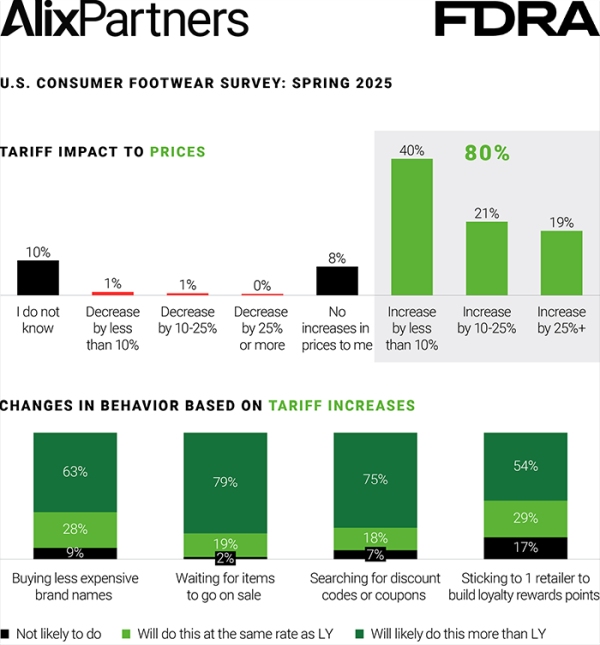- in United States
- within Real Estate and Construction topic(s)
Spring 2025 U.S. Footwear Consumer Survey from AlixPartners, in partnership with FDRA, also reveals athletic shoe market is wearing thin
NEW YORK (April 30, 2025) -- Price is top of mind for consumers shopping for shoes, with 78% saying they have walked away from a shoe purchase due to cost, up 12 percentage points from last year. That is among the findings revealed in the new Spring 2025 AlixPartners U.S. Footwear Consumer Survey, conducted in partnership with the Footwear Distributors and Retailers of America (FDRA).
The study also found that U.S. consumers plan to cut spending on athletic footwear this spring and summer as part of a broader pushback against rising prices that are being fueled by trade tariffs. Athletic sales hadn't fallen in any of the previous four years of the survey and sneakers, sports and multiactivity shoes have been the most buoyant segment in recent years.
The reversal is part of a broader reshaping of consumer behavior in the U.S., where imports account for around 99% of shoe sales and carried an average tariff of around 12% before the latest round of levies.
"The uncertainty is the problem," said Bryan Eshelman, Partner & Managing Director, AlixPartners. "Consumers have been hit by inflation and supply-chain disruption in recent years, and now they're worried about the price impacts of trade policy. In the immediate term, they're cutting back across categories. Of those reducing their spend, 49% cite a focus on necessities as a big reason."
Consumers are planning to reduce their spending on all shoe categories this year, with work shoes/boots (down 29%) and fashion/dress footwear (down 26%) taking the biggest hits compared to last year, followed by athleisure/multiactivity shoes (17% drop) and casual shoes (down 16%). Some 43% of survey respondents expect to spend no money at all on work shoes, indicating consumers plan to cut back on core purchases by trying to extend the life of footwear they already have.
Retailers can expect a gloomier scenario playing out as tariffs bite, with initial signs that consumers are already pulling forward spending on big-ticket items. "The 2025 U.S. Footwear Consumer Survey results confirm what we're hearing across the industry – consumer confidence is slipping and price sensitivity is peaking," said Matt Priest, CEO & President of FDRA, citing the FDRA's Shoe Executive Business Survey. "With nearly 80% of consumers bracing for higher costs due to tariffs and nearly 8 in 10 walking away from a shoe purchase because of the price tag, footwear is shifting from a necessity to a discretionary expense for many families. This in turn is likely to impact U.S. footwear businesses trying to meet shifting consumer demands."
"When consumers are focused on their budgets, they're looking for sales and discounts—and brand loyalty becomes an afterthought," said Sonia Lapinsky, Partner & Managing Director and Leader of Fashion Retail at AlixPartners. "On top of that, our latest research shows that consumers think footwear loyalty programs are less effective than other categories' programs, with only 5% saying footwear rewards prompt them to shop and spend more. That underscores how crucial it is for retailers to understand who their customers are and meet their expectations across product, price and experience."
Key Findings:
- Tariff Awareness Grows: Some 80% of consumers anticipate price hikes when new tariffs are enacted, and many expect retailers to absorb the brunt.

- Source: Spring 2025 U.S. Footwear Consumer Survey, AlixPartners in partnership with FDRA
- Price Sensitivity Peaks: Nearly 6 in 10 (59%) of those surveyed said lack of a promotion was a reason to ditch the purchase, up 11 percentage points from last year.
- If The Shoe Doesn't Fit: Despite investments in AI features like fit finders and chatbots, online shoppers remain skeptical about these tools. In-store purchases continue to dominate due to fit reliability.
- Speed and Convenience Wins: Consumer demand for next-day delivery of shoes has doubled since last year. BOPIS and curbside pickup also have surged, though in-store shopping still leads.
- Loyalty Wanes: Only 5% of respondents say loyalty programs influence them to buy more, indicating weak returns from reward initiatives.
- Demographic Differences: Younger consumers (ages 18–44) are more willing to pay extra for customization, performance and tech features in shoes, with about 70% of this age group saying they would pay more for custom fit and personalization. Interest in these features drops significantly among those over 45 to less than 3 in 10. Older consumers (over 45) prioritize durability, with a majority valuing robust construction. Surprisingly, both teens (18 and under) and midlife adults (45–54) show a strong willingness to pay more for stylish designs, whereas most other age groups focus on practicality and affordability.
Industry Response
Imports account for around 99% of U.S. footwear, but some imports
also rely on U.S. exports of shoe components. Under new U.S. trade
policy, big producers such as China, Vietnam and Indonesia face
higher levies on their output—with China most heavily
affected. Brands must act decisively. Strategic cost management,
sharper inventory decisions and better marketing alignment with
consumer demand will be critical. Retailers and manufacturers that
meet consumers where they are—balancing price, speed, and
value—will come out ahead.
About the Survey
The Spring 2025 U.S. Footwear Consumer Survey was conducted online
from February 28 to March 10, 2025, with 1,006 U.S. footwear
consumers aged 15 and older, representing a broad cross-section of
demographics and regions.
For more information about the survey, follow this link to our report, "Can footwear consumers absorb another shock?"
The content of this article is intended to provide a general guide to the subject matter. Specialist advice should be sought about your specific circumstances.






